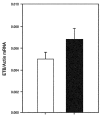Endothelin receptor alterations in equine airway hyperreactivity
- PMID: 16548332
- PMCID: PMC1325094
Endothelin receptor alterations in equine airway hyperreactivity
Abstract
The purpose of this study was to evaluate the role of endothelin-1 (ET-1) and its receptors in the airway hyperreactivity of horses with obstructive pulmonary disease associated with summer pasture (SPAOPD). The right diaphragmatic lobe of the lung of 8 clinically healthy (unaffected) and 8 SPAOPD-affected horses was collected immediately after euthanasia. Bronchial rings (4 mm wide) were prepared and mounted in organ baths and attached to force transducers interfaced with a polygraph. Four rings were used to study each ET-1 receptor; 1 ring served as the control, and the other 3 were incubated with 10(-9), 10(-7), or 10(-5) M of either BQ-123, an ET(A)-receptor antagonist, or IRL-1038, an ET(B)-receptor antagonist. Cumulative concentrations (10(-8.5) to 10(-6) M) of ET-1 were applied to all rings. Using pooled pulmonary tissue from different regions of the lung, we performed a reverse-transcription polymerase chain reaction (RT-PCR) to determine ET(B)-receptor gene expression. Although ET-1 caused concentration-dependent bronchial ring contraction in both groups of horses, the rings of SPAOPD-affected horses had significantly greater contraction than the rings of unaffected horses. Whereas ET(A)-receptor blockade significantly increased the response to ET-1 in unaffected horses, ET(B)-receptor blockade significantly decreased the response in affected horses. The pA2 values showed a nonsignificant decrease in ET(A)-receptor affinity and a significant increase in ET(B)-receptor affinity in affected horses compared with unaffected horses. The ET(B)-receptor mRNA expression of the pooled pulmonary tissue showed a nonsignificant increase in affected horses compared with unaffected horses. The airway hyperreactivity to ET-1 observed in the bronchial rings from the affected horses appears to be due in part to activation of pulmonary ET(B) receptors, which appear to be inactive in unaffected horses.
Afin d’évaluer le rôle de l’endotheline-1 (ET-1) et de ses récepteurs dans l’hyper-réactivité des voies respiratoires de chevaux avec une maladie pulmonaire obstructive associée au pâturage d’été (SPAOPD), le lobe diaphragmatique droit du poumon de 8 chevaux cliniquement sains (non-affectés) et 8 chevaux souffrant de SPAOPD a été prélevé immédiatement après l’euthanasie. Des anneaux bronchiques (4 mm de largeur) ont été préparés et montés dans des bains d’organe et attachés à des transducteurs de force interfacés à un polygraphe. Quatre anneaux ont été utilisés pour étudier chaque récepteur de l’endotheline; 1 anneau servait de témoin, et les 3 autres anneaux ont été incubés avec 10−9, 10−7 ou 10−5 M de BQ123, un antagoniste de récepteur ETA, ou IRL1038, un antagoniste de récepteur ETB. Des concentrations cumulatives (10−8,5 à 10−6 M) de ET-1 ont été appliquées à tous les anneaux. En utilisant un pool de tissu pulmonaire provenant de différentes régions du poumon, une épreuve d’amplification en chaîne par la polymérase utilisant la transcriptase reverse (RT-PCR) a été effectuée pour déterminer l’expression du gène du récepteur ETB. Bien que ET-1 ait entraîné une contraction dose-dépendante des anneaux bronchiques dans les deux groupes de chevaux, les anneaux de chevaux souffrant de SPAOPD montraient une contraction significativement plus marquée que les anneaux des chevaux sains. Alors que le bloc des récepteurs ETA augmenta significativement la réponse à ET-1 chez les chevaux normaux, le bloc de ETB diminua significativement la réponse chez les chevaux malades. Les valeurs de pA2 ont montré une réduction non-significative de l’affinité pour le récepteur ETA et une augmentation significative pour le récepteur ETB chez les chevaux malades comparativement aux chevaux sains. L’expression de l’ARNm de ETB dans le pool de tissu pulmonaire a montré une augmentation non-significative chez les chevaux malades comparativement aux animaux sains. L’hyper-réactivité des voies respiratoires envers ET-1 observée dans les anneaux bronchiques des chevaux malades semble être causée en partie à l’activation des récepteurs pulmonaires ETB, récepteurs qui semblent inactifs chez les chevaux cliniquement normaux.
(Traduit par Docteur Serge Messier)
Figures






Similar articles
-
Characterization of endothelin receptors in the peripheral lung tissues of horses unaffected and affected with recurrent airway obstruction.Can J Vet Res. 2008 Jul;72(4):340-9. Can J Vet Res. 2008. PMID: 18783023 Free PMC article.
-
Comparative responses of bronchial rings to mediators of airway hyperreactivity in healthy horses and those affected with summer pasture-associated obstructive pulmonary disease.Am J Vet Res. 2001 Feb;62(2):259-63. doi: 10.2460/ajvr.2001.62.259. Am J Vet Res. 2001. PMID: 11212036
-
Immunohistochemical determination of the expression of endothelin receptors in bronchial smooth muscle and epithelium of healthy horses and horses affected by summer pasture-associated obstructive pulmonary disease.Am J Vet Res. 2006 Feb;67(2):348-57. doi: 10.2460/ajvr.67.2.348. Am J Vet Res. 2006. PMID: 16454644
-
Effect of potential therapeutic agents in reducing oxidative stress in pulmonary tissues of recurrent airway obstruction-affected and clinically healthy horses.Equine Vet J. 2013 Jan;45(1):80-4. doi: 10.1111/j.2042-3306.2012.00566.x. Epub 2012 Apr 17. Equine Vet J. 2013. PMID: 22506732
-
Small airway disease as a vanguard for chronic obstructive pulmonary disease.Vet Clin North Am Equine Pract. 1997 Dec;13(3):549-60. doi: 10.1016/s0749-0739(17)30230-4. Vet Clin North Am Equine Pract. 1997. PMID: 9368979 Review.
Cited by
-
Characterization of endothelin receptors in the peripheral lung tissues of horses unaffected and affected with recurrent airway obstruction.Can J Vet Res. 2008 Jul;72(4):340-9. Can J Vet Res. 2008. PMID: 18783023 Free PMC article.
-
Neurokinin receptors in recurrent airway obstruction: a comparative study of affected and unaffected horses.Can J Vet Res. 2009 Jan;73(1):25-33. Can J Vet Res. 2009. PMID: 19337392 Free PMC article.
References
-
- Beadle RE. Summer pasture-associated obstructive pulmonary disease. In: Robinson NE, ed. Current Therapy in Equine Medicine. Philadelphia, Pennsylvania: WB Saunders, 1983: 512–516.
-
- Seahorn TL, Beadle RE. Summer pasture-associated obstructive pulmonary disease. Equine Pract. 1994;16:39–41.
-
- Robinson NE. Recurrent airway obstruction (heaves). In: Lekeux P, ed. Equine Respiratory Diseases. Ithaca, New York: International Veterinary Information Service (www.ivis.org), 2001:doc B0317.1101.
-
- Buechner-Maxwell V. Airway hyperresponsiveness. Equine respiratory disorders. Compend Contin Educ Pract Vet. 1993;15:1379–1389.
Publication types
MeSH terms
Substances
LinkOut - more resources
Full Text Sources
